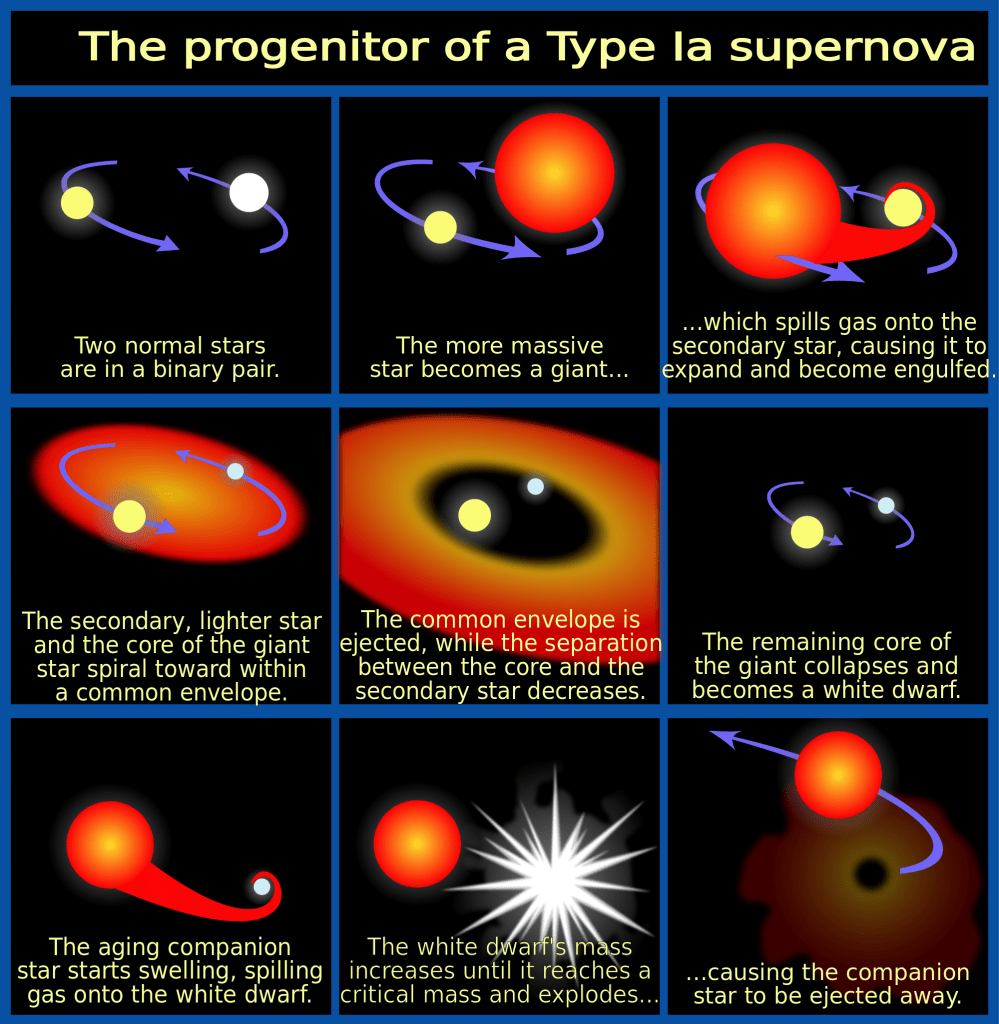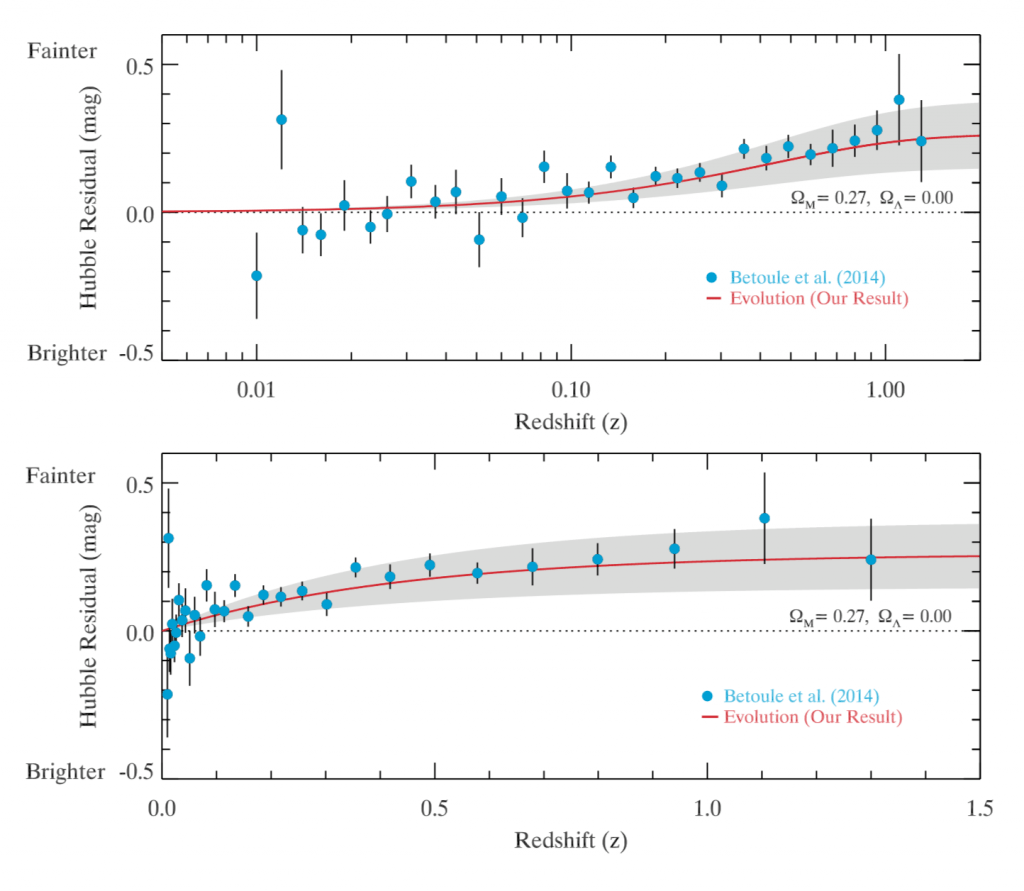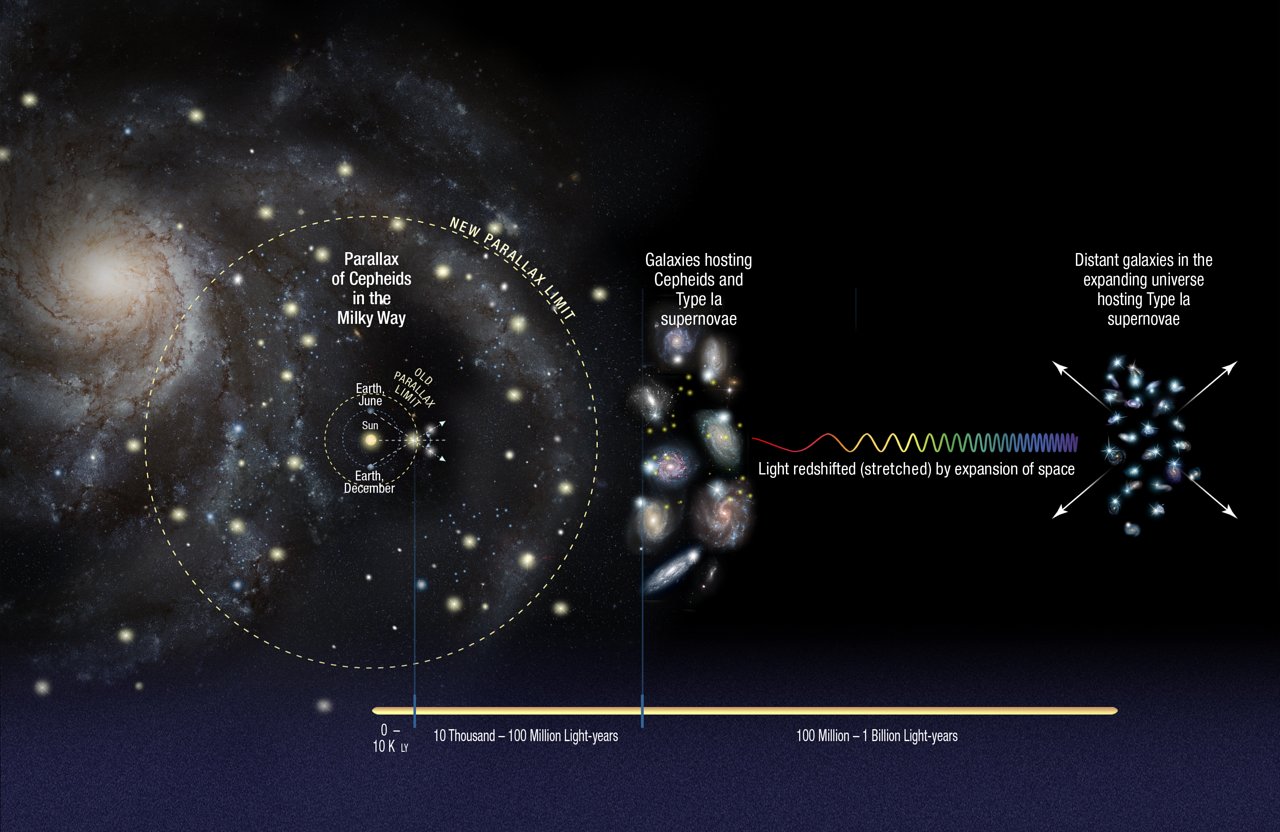The universe is expanding. When we look in all directions, we see distant galaxies speeding away from us, their light redshifted due to cosmic expansion. This has been known since 1929 when Edwin Hubble calcuated the relation between a galaxy’s distance and its redshift. Then in the late 1990s, two studies of distant supernovae found that the expansion of the universe is accelerating. Something, some dark energy, must be driving cosmic expansion.
Dark energy is now part of the concordance model of cosmology. It is thought to make up about 68% of the matter-energy in the universe. While there is a wealth of data to support dark energy, the model isn’t without its problems. And new research even suggests it might not exist. That’s a bold claim, so let’s look at the data.

The relation between galactic redshift and galactic distance is now known as the Hubble constant, or more generally the Hubble parameter. By determining the Hubble parameter and measuring the density of matter in the universe we can determine how much dark energy there is in the universe. The redshift of a galaxy is pretty easy to determine, but measuring the distance is difficult.
Hubble determined distance by observing Cepheid variables, which have a strong period-luminosity relation. This relation was discovered by Henrietta Leavitt, who studied more than 1,700 Cepheid variables. By measuring the period of a Cepheid variable you know its absolute magnitude (real brightness). Compare this to its apparent magnitude (apparent brightness) and you know the star’s distance.
This method only works for Cepheids in galaxies less than 20 million light-years away. For really distant galaxies, astronomers observe a kind of supernova known as Type Ia. These occur when a white dwarf explodes, and their absolute magnitudes are fairly similar. Just as Cepheids can be used to calculate distance, so can these supernovas. But supernovas are so bright they can be used to measure the distance of galaxies billions of light-years away. The first evidence of dark energy was found through observations of distant Type Ia supernovae.

One of the fundamental assumptions about Type Ia supernovae is that no matter where they occur in the universe, their maximum brightness is always about the same. This makes sense because white dwarfs have an absolute maximum mass known as the Chandrasekhar Limit (about 1.4 solar masses). So the supernovae all explode with about the same mass-energy, hence the same brightness. This was confirmed by observing supernovae that occur closer than 20 million light-years.
As more studies were done, it was found that not all Type Ia supernovae are the same. They can occur when a single white dwarf explodes, but they can also occur when two white dwarfs merge. In fact, the merger version seems to be more common, and in those the mass can be greater than the Chandrasekhar Limit. There is also a variation known as Type Iax, where the white dwarf doesn’t completely explode. Both of these differ in brightness from the standard version, and that could throw off your distance measurement.

While this makes distance measurements more complicated, it is something astronomers can compensate for. There are subtle differences in the way these supernovae brighten and dim (known as their light curve) and so they can generally be distinguished. But the laws of physics are the same everywhere in the cosmos, so as long as we pick the right supernovae and adjust for a few factors our distance measurements should be good.
Or so we thought.
A new study casts doubt on our assumption about Type Ia supernovae. Over nine years, the team made detailed spectrographic observations of all the nearby galaxies where supernova occurred. From this, they calculated the ages of these galaxies. They also looked at the light curves of the supernovae that occurred in these galaxies. Since these galaxies are all within the range of Cepheid variables, the team knew the distances without making assumptions about supernovae.
With all this data, they then looked at whether the light curve of a supernova depended upon the overall age of stars in the host galaxy. They found a strong relationship. In other words, the brightness of supernovae evolves over time, and the assumption that they are all about the same doesn’t quite hold.

This is important. Because of the speed of light, when we look at distant galaxies we see younger galaxies. It takes billions of years for their light to reach us. If supernova evolution is true, then it throws off all of our distance measurements. Our measurements of cosmic acceleration and dark energy could be wrong. In fact, when the team compared their evolution model to the acceleration model, they found they gave the same result. Their evolution model removes the need for dark energy. What looks like an accelerating universe could be due to supernova evolution. If they are right, then dark energy might not exist.
This is a surprising and important result, but we shouldn’t jump to conclusions. While the evidence for supernova evolution looks pretty strong, there is currently only data for nearby galaxies. To eliminate dark energy, the team assumed their model can be extended to large distances. The current model assumes supernovae don’t evolve at large distances. There is also other evidence for dark energy from observations of the cosmic microwave background and the way galaxies cluster at large scales. There is still plenty of evidence for dark energy.
But this new research could help answer another mystery, known as the Hubble tension. Basically, we aren’t entirely sure what the Hubble constant is. Methods such as the cosmic background give a value around 67 (km/s)/Mpc, while supernova measurements give a value around 73 (km/s)/Mpc. It used to be that the uncertainties were so large this difference didn’t matter, but now the uncertainties are so small different methods disagree. This evolution of supernovae might not eliminate dark energy, but it might help solve the tension in Hubble results.
Either way, this result is exciting.
Source: Kang, Yijung, et al. “Early-type Host Galaxies of Type Ia Supernovae. II. Evidence for Luminosity Evolution in Supernova Cosmology.”


Exciting? I don’t think that is the general consensus, here is how cosmologists described the earlier round of non-DE papers:
“No Dark Energy? No Chance, Cosmologists Contend.” [ https://www.quantamagazine.org/no-dark-energy-no-chance-cosmologists-contend-20191217/ ]
Tutusaus et al suggest to relax the SN1a redshift like the work here, and not surprisingly can find a better curve fit with a more complex model; they use 5 SN1a. But besides that unwarranted assumption they run into problems with the Hubble rate value instead [ https://arxiv.org/pdf/1803.06197.pdf ].
The current work picks a handful of SN1as and make an extraordinary claim at 2.8 sigma. The dark energy data set contains more than a thousand [!] SN1as [ https://iopscience.iop.org/article/10.3847/1538-4357/aaa5a9/meta ] and is tested to ~ 5 sigma.
(Technically they do a chi-square test, so I’m eye balling it from their comparison with non-DE power laws – Riess et al are 2 order of magnitude better. But that is also the tension in the local vs global Hubble rate, so we should also not expect any better confidence IMO. Also, I think these non-DE papers somewhat rely on that tension, at least indirectly.)
The main problem with these non-DE papers is that they are opportunistic, including cherry picking and recycling of old claims. For another example, the recent Di Valentino, Melchiorri, & Silk 2019 work (that Sarkar et al referenced): “When researchers reanalyzed the gold-standard data set of the early universe, they concluded that the cosmos must be “closed,” or curled up like a ball. Most others remain unconvinced. … “it is just a statistical fluke.”” [ https://www.quantamagazine.org/what-shape-is-the-universe-closed-or-flat-20191104/ ]
The main take away seems to be [the first link above]:
“Those who find the back-and-forth about data analysis hard to follow should note that the data from supernovas matches other evidence of cosmic acceleration. Over the years, dark energy has been inferred from the ancient light called the cosmic microwave background, fluctuations in the density of the universe called baryon acoustic oscillations, the gravitationally distorted shapes of galaxies, and the clustering of matter in the universe.”
So, will it help remove the tension in Hubble rate observations (which would be exciting)? Since Reiss et al has amassed such a large data set, I doubt it. As a side note, I’m not overly fond of the philosophic description of constraints as “assumptions”. Used constraints are tested with the data, and if the science process converge it will also converge on useful (data and) constraints.
If Dark Energy is proved not to exist, will we be back to the expanding and slowing universe? In 1998, when I first read about the accelerating universe, I thought no way, that theory will eventually be overturned.